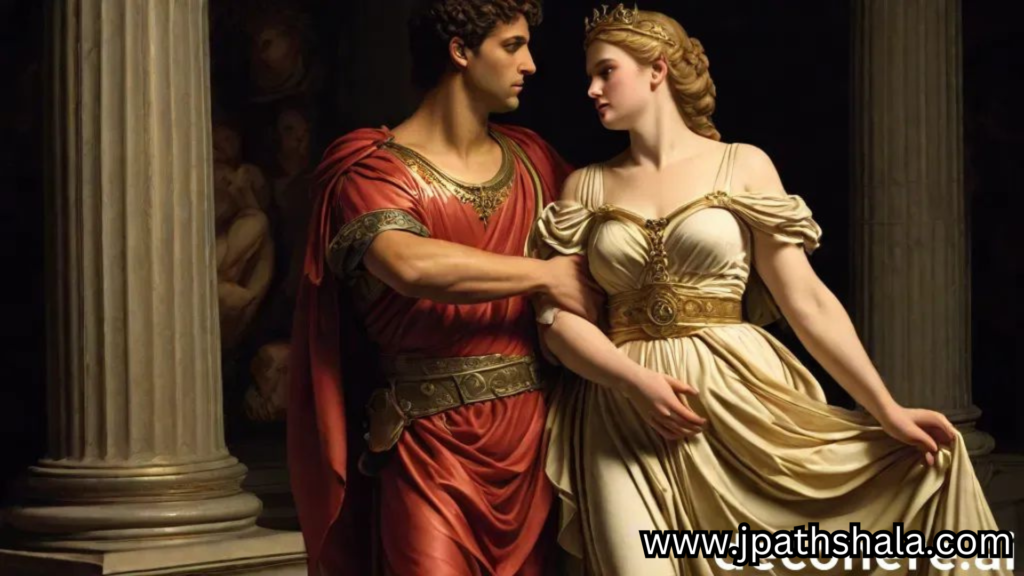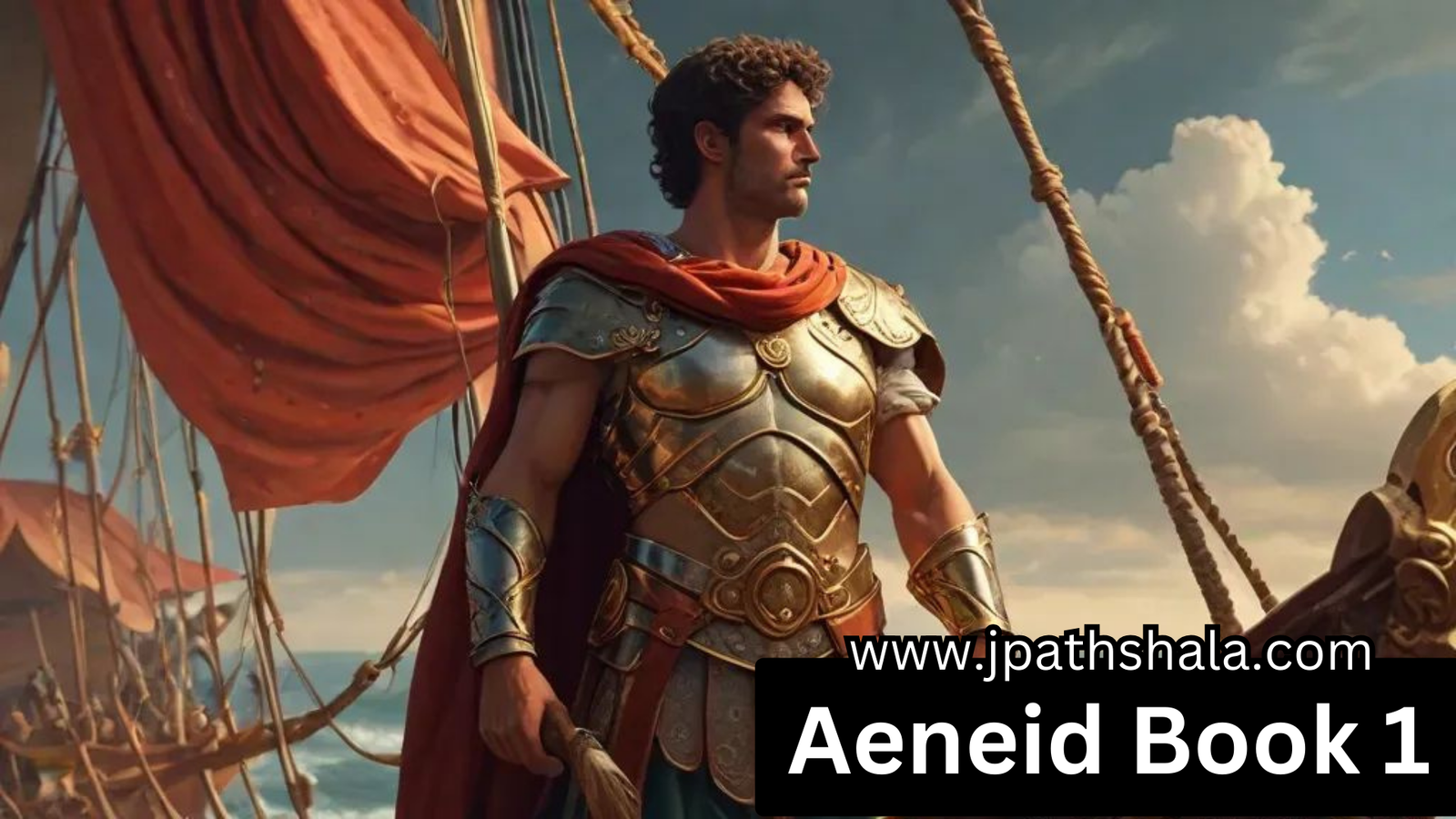Aeneid Book 1: The “Aeneid” is an epic poem written by the ancient Roman poet Virgil (Publius Vergilius Maro). It was composed between 29 and 19 BCE, during the last decade of Virgil’s life. The poem is divided into twelve books and follows the journey of Aeneas, a Trojan hero, who travels to Italy after the fall of Troy. Aeneas’s destiny is to lay the foundations for what will eventually become Rome, linking the mythic past of Troy with the historical rise of Rome. The “Aeneid” is celebrated for its poetic artistry and its profound influence on Western literature and culture.
Aeneid characters
Aeneas: The protagonist, a Trojan prince and the son of Anchises and Venus. He is destined to found the Roman race in Italy.
Anchises: Aeneas’s father, who dies during the journey but continues to guide his son as a spirit.
Ascanius (Iulus): Aeneas’s young son, who represents the future of the Trojan people.
Dido: The queen of Carthage who falls in love with Aeneas and ultimately commits suicide when he leaves her.
Turnus: The chief antagonist, leader of the Rutulians in Italy, and Aeneas’s primary rival.
Creusa: Aeneas’s wife who dies during the fall of Troy.
Lavinia: The daughter of Latinus, king of the Latins, and the destined bride of Aeneas.
Latinus: The king of the Latins who initially welcomes Aeneas.
Amata: The wife of Latinus who opposes Aeneas and favors Turnus as Lavinia’s suitor.
Evander: The king of Pallanteum, an ally of Aeneas.
Pallas: The son of Evander who is killed by Turnus, inciting Aeneas’s wrath.
Aeneid Book 1 Summary
Prologue and Invocation (Lines 1-33)
Virgil opens the epic by invoking the Muse, asking for her help in telling the story of Aeneas, a Trojan hero who is destined to reach Italy and find a new city. He introduces the theme of Aeneas’s suffering and the relentless anger of Juno, who opposes him because of her favouritism towards Carthage and lingering resentment from the Trojan War.
Aeneas’s Journey and the Storm (Lines 34-123)

Aeneas and his fleet are sailing towards Italy when Juno, still wrathful, enlists the help of Aeolus, the god of the winds. She promises him a nymph as a reward if he unleashes his winds to destroy the Trojan fleet. Aeolus agrees, causing a violent storm that scatters the ships. Neptune, the god of the sea, notices the turmoil and calms the waters, reprimanding Aeolus for acting without his permission.
Arrival in Carthage (Lines 124-304)
Aeneas and seven of his ships manage to reach the coast of Libya. They land near Carthage, where Aeneas encourages his men, reminding them of past hardships and the promise of a future homeland. Venus, Aeneas’s divine mother, sends Cupid to ensure Queen Dido falls in love with Aeneas, hoping this will secure her son’s safety.
Aeneas and Achates Explore (Lines 305-417)
Disguised as a huntress, Venus appears to Aeneas and Achates, reassuring them and directing them to Carthage. She envelops them in a mist to keep them hidden as they enter the city. Carthage is bustling with construction, and Aeneas is awed by its progress.
Encounter with Dido (Lines 418-519)

Aeneas and Achates witness a grand temple to Juno, where they see depictions of the Trojan War. Dido arrives, displaying her regal and kind nature. She offers asylum to the Trojans, still unaware of Aeneas’s presence.
Revelation and Welcome (Lines 520-756)
Venus dispels the mist, revealing Aeneas. He introduces himself and expresses gratitude for Dido’s generosity. Dido is enthralled and invites the Trojans to a feast. She listens eagerly to Aeneas’s story, setting the stage for his recounting of his past adventures and trials.
Venus and Juno’s Plot (Lines 757-903)
Fearing Juno’s wrath, Venus sends Cupid to ensure Dido’s love for Aeneas deepens. Disguised as Aeneas’s son, Ascanius, Cupid works his magic during the banquet. Dido becomes increasingly enamoured with Aeneas, hinting at the divine machinations.
Conclusion of Book 1
The book ends with the Trojans feasting and Aeneas preparing to tell the story of the fall of Troy and his subsequent wanderings. This narrative will continue in the subsequent books, detailing Aeneas’s epic journey and the founding of the Roman race.
Theme
Book 1 of Virgil’s Aeneid introduces several key themes that are integral to the epic. Here are some of the primary themes explored:
- Fate and Destiny: The theme of fate is central to the Aeneid. Aeneas is destined to found a new Trojan state that will become Rome. Despite the numerous obstacles he faces, his fate is preordained by the gods. This theme underscores the inevitability of destiny and the idea that forces beyond their control often guide individuals.
- Piety and Duty: Aeneas is often described as “pious Aeneas,” highlighting his devotion to duty, the gods, and his people. His sense of duty drives him to endure hardships and make personal sacrifices. This theme emphasizes the Roman virtues of duty, loyalty, and piety.
- Divine Intervention: The gods play a crucial role in the lives of mortals. Juno’s anger and her attempts to thwart Aeneas’s mission contrast with Venus’s support for her son. The involvement of the gods illustrates the belief in divine power and the impact of divine will on human affairs.
- Suffering and Struggle: Aeneas’s journey is marked by suffering and struggle, reflecting the trials faced by those who strive to fulfill their destiny. The theme of suffering also highlights the cost of greatness and the perseverance needed to achieve it.
- War and Conflict: The Aeneid opens in the aftermath of the Trojan War, and the specter of war looms over Aeneas’s journey. The theme of war examines its devastation, the heroism it demands, and its role in the founding of civilizations.
- Leadership and Heroism: Aeneas embodies the qualities of a leader and a hero. His leadership is characterized by his ability to inspire and guide his followers, his bravery in the face of danger, and his commitment to his mission.
- Identity and Homeland: The search for a new homeland is a central element of Aeneas’s journey. This theme explores the concept of identity, belonging, and the longing for a place to call home. Aeneas’s journey reflects the broader human experience of seeking stability and purpose.
In summary, Book 1 of the Aeneid sets the stage for the epic’s exploration of fate, duty, divine influence, and the challenges of heroism and leadership. These themes not only define Aeneas’s character but also reflect the values and beliefs of Roman society.
Aeneid Book 1 FAQ
1. Who is the author of the “Aeneid”?
The “Aeneid” was written by the ancient Roman poet Virgil (Publius Vergilius Maro).
2. What is the main theme of Book 1?
The main themes of Book 1 include fate and destiny, divine intervention, duty (pietas), and the struggles of Aeneas and his followers as they seek to fulfill their destiny in founding a new city in Italy.
3. Why does Juno oppose Aeneas?
Juno opposes Aeneas because she harbors a grudge against the Trojans, stemming from the Judgment of Paris, and she fears that Aeneas’s descendants will one day destroy her favorite city, Carthage.
4. How does Juno attempt to thwart Aeneas’s journey?
Juno enlists Aeolus, the god of the winds, to unleash a storm that scatters and threatens to destroy Aeneas’s fleet.
5. How does Neptune respond to the storm?
Neptune, the god of the sea, calms the storm and reprimands Aeolus for causing chaos without his permission, ensuring the safety of Aeneas’s fleet.
6. Where does Aeneas land after the storm?
Aeneas and his surviving ships land on the coast of Libya, near the city of Carthage.
7. Who is Dido, and what is her role in Book 1?
Dido is the queen of Carthage. She welcomes Aeneas and his followers, offering them hospitality and asylum. She becomes enamored with Aeneas, partly due to divine intervention by Venus and Cupid.
8. How does Venus protect Aeneas upon his arrival in Carthage?
Venus disguises herself as a huntress to guide Aeneas and Achates to Carthage and then envelops them in a protective mist to keep them hidden as they explore the city.
9. What significant structure does Aeneas see in Carthage, and what is its importance?
Aeneas sees a grand temple to Juno, which features depictions of the Trojan War. This structure underscores the connection between the Trojans’ past and their present situation, as well as the power and influence of Juno.
10. How does Book 1 end?
Book 1 ends with the Trojans feasting in Carthage, with Aeneas preparing to recount the story of the fall of Troy and his subsequent wanderings. This sets the stage for the narrative in the following books.
11. What role do the gods play in Book 1?
The gods play a significant role, with Juno opposing Aeneas and Venus aiding him. Divine interventions drive much of the plot, showcasing the influence of the gods on mortal affairs.
12. What is the significance of Aeneas’s duty (pietas) in Book 1?
Aeneas’s sense of duty, or pietas, is crucial as it highlights his commitment to his family, his people, and the gods. This sense of duty motivates his actions and decisions throughout the epic.
This FAQ addresses key questions about Book 1 of the “Aeneid,” providing a foundation for understanding the plot, characters, and themes introduced at the beginning of Virgil’s epic poem.
